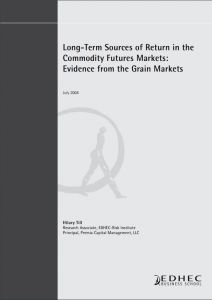

Long-Term Sources of Return in the Commodity Futures Markets: Evidence from the Grain Markets
This article provides some preliminary contributions to the debate over the sources of return in the commodity markets, based on work that is drawn from the 2007 Risk Book, Intelligent Commodity Investing. Essentially, Till (2007) and Feldman and Till (2006) find that in examining a 55-year period in three grain futures markets that the term-structure of an individual contract is the dominant source of return, but only over long (five-year) time-frames. During periods of price stability, grain commodity futures prices have been naturally mean-reverting, meaning that sources of return obviously could not be from trends in the spot price; instead, they had to be from secondary (non-obvious) factors like the shape of a commodity market’s futures curve.
Author(s):
Summary:
This article provides some preliminary contributions to the debate over the sources of return in the commodity markets, based on work that is drawn from the 2007 Risk Book, Intelligent Commodity Investing. Essentially, Till (2007) and Feldman and Till (2006) find that in examining a 55-year period in three grain futures markets that the term-structure of an individual contract is the dominant source of return, but only over long (five-year) time-frames. During periods of price stability, grain commodity futures prices have been naturally mean-reverting, meaning that sources of return obviously could not be from trends in the spot price; instead, they had to be from secondary (non-obvious) factors like the shape of a commodity market’s futures curve.
Register to download PDF
Register/Log in| Type : | Working paper |
|---|---|
| Date : | 07/07/2008 |
| Keywords : |
Commodities |

